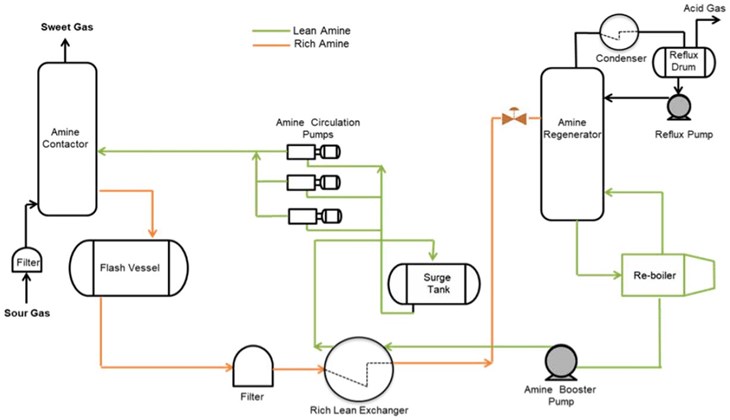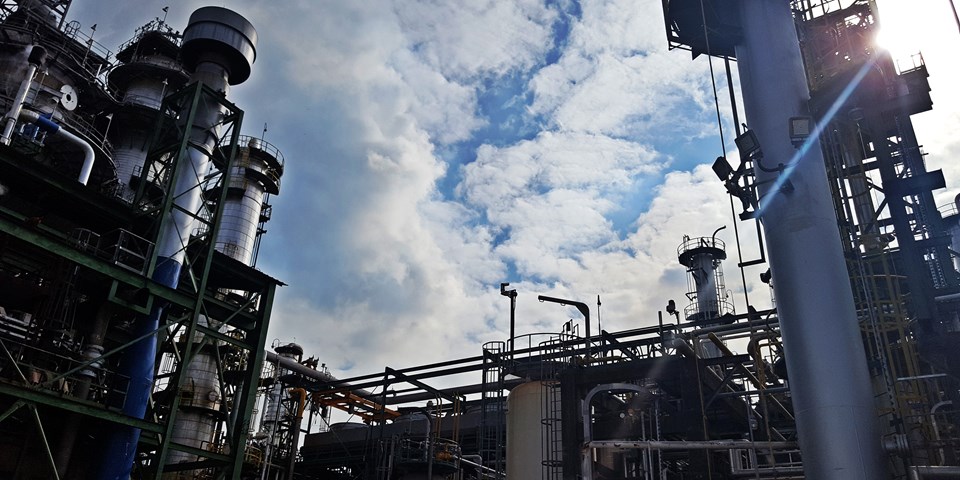What is the contribution of stainless steel in mitigating amine corrosion? This article discusses the answers to these important questions.
By Fahad Muhammad, Asset Integrity Engineer.
What is amine corrosion?
Raw natural gas exists under pressure in deep reservoirs and often contain constituents like carbon dioxide (CO2) and hydrogen sulphide (H2S). It is critical to remove the CO2 and H2S, collectively known as ‘acid gases’, to enhance the heat content of natural gas and meet the sales gas specification. One of the most widely used commercial processes to remove acid gases from raw gas is an amine sweetening process. An amine sweetening plant is comprised of different equipment and piping and uses an amine solution to remove H2S and CO2. A typical amine process is depicted in Figure 1.
Acid gases absorbed in the amine solution (which is amine diluted with water), along with other contaminants, can cause significant corrosion or loss of metal in equipment and piping of amine plants. In line with API 571, amine corrosion is defined as: “General and/or localized corrosion that occurs principally on carbon steel in amine treating processes. Corrosion is not caused by the amine itself but results from dissolved acid gases (CO2 and H2S), amine degradation products, Heat Stable Amine Salts (HSAS) and other contaminants”.1
Contributing factors
Various factors such as plant material of construction, design and operating practices, the type of amine, amine concentration, contaminants, temperature, and velocity all contribute to the amine corrosion process. Five major contributing factors are:
Amine solution concentration:
H2S and CO2 from feed gas are absorbed into the amine solution by chemical reaction, to form rich amine (orange marked piping in Figure 1). Rich amine is considered highly corrosive due to dissolved acid gases and impurities. On the other hand, amine downstream of a regenerator for return contains a very low amount of dissolved acid gases and is called ‘lean amine’ (green marked piping in Figure 1). Lean amine is generally not corrosive because they have no dissolving gases with low conductivity and/or high pH.
Construction material:
Carbon steel is largely prone to amine corrosion and is primarily used for lean amine services only. Stainless steel, mainly 300 series, is highly resistant against amine corrosion and is mainly used for rich amine piping and equipment.
Amine type:
Corrosion also relies on the type of amine used, as different types of amines are utilized across the globe. In general, alkanolamine systems can be rated in order of aggressiveness from most to least as follows: Monoethanolamine (MEA), Diglycolamine (DGA), Diisopropylamine (DIPA), Diethanolamine (DEA), and Methyldiamine (MDEA).
Design and operation:
Amine corrosion is very closely linked to the operation of the unit. Several problems can be traced to faulty design, poor operating practices, or solution contamination. Specific attention should be given to acid gas loading levels (amount of gas picked up by amine solution) and reboiler rates to control corrosion.
Temperature and velocity:
Corrosion rates increase when the temperature rises, particularly in rich amine services. Temperatures greater than 220°F (104°C) can initiate acid gas flashing and severe localized corrosion. Moreover, process stream velocity will influence the amine corrosion rate and the nature of attack. For carbon steel, velocity limits are generally limited to 1.8 m/s for rich amine and about 6 m/s for lean amine. For stainless steels, higher velocities can be used.
Other factors, such as the accumulation of HSAS and/or oxygen ingress, also play a part in amine corrosion.
Susceptible equipment
The amine regenerator column and re-boiler are the zones where high temperatures and turbulence of the rich amine streams can trigger substantial corrosion problems. In addition, overhead condensers, piping, and reflux drums are high corrosion-sensitive areas as well.

Morphology of damage
Use of stainless steel to prevent corrosion
In amine plants there are certain vulnerable equipment and piping where high likelihood of amine corrosion demands the use of corrosion resistant alloy or stainless steel for corrosion mitigation. Following is the high-level material combination generally recommended for key components in amine units.
Absorber:
Carbon steel with stainless steel cladding.
Flash drum:
Carbon steel with stainless steel cladding.
Heat exchangers (tubes):
Stainless steel.
Regenerator:
Carbon Steel with stainless steel internals.
Reflux drum:
Carbon Steel with stainless steel cladding.
Rich amine piping:
Stainless steel.
Lean amine piping:
Carbon steel.
Material selection is influenced by several factors including cost effectiveness, however, material grades typically used in the industry to combat amine corrosion are provided below.
Rich amine piping:
All the piping carrying rich amine solutions are typically constructed from austenitic stainless steels, such as 304L and 316L, to overcome amine corrosion. Stainless steel also helps in minimizing the erosion-corrosion risk due to higher velocities at elbows, reducers, etc.
Regenerator:
The regenerator is normally designed with a carbon steel shell and corrosion resistant alloy cladding such as 400 series stainless steel. The internals of regenerator, such as trays and down comers, which is a pipe through which amine solution falls into the next tray, are normally made up of martensitic stainless steels such as SS410. Austenitic stainless steels, mostly 316L, are also used for internals to avoid corrosion due to turbulences or impingement because of the hot rich amine, as well as corrosion by acidic gas.
Re-boiler:
Heating tubes of reboilers have also shown some corrosion failures due to the high concentration of amine degradation products or from severe heating. Austenitic stainless steels such as 316L are considered as the preferred material to build these tubes. The use of stainless steel also provides increased operational flexibility such as higher acid gas loading levels with improved plant efficiency.
Reflux system:
Due to the immense condensation of acid water, the acid gas overhead outlet of the regenerator is another corrosion prone area. Critical components like condenser tubes are generally made up of austenitic stainless steels such as 304L and 316L. Reflux drums are fabricated from carbon steel with austenitic stainless-steel cladding. The reflux pump casing and impeller should be 316 stainless steel as well. All the reflux piping is typically 316L stainless steel.
Overall, solid or clad austenitic and martensitic stainless steel are excellent choices for mitigating amine corrosion in prone areas of amine plants. However, while using austenitic stainless steels, care must be taken in controlling the chloride content of the amine solution, as higher chlorides leads to stress corrosion cracking (SCC). For areas with a high chloride susceptibility, duplex stainless steel, such as 2205, is commonly used.
Tracking amine corrosion
Monitoring for amine corrosion should target the hot areas of the unit, such as the reboiler feed and return line, the hot lean/rich amine piping, and the regenerator overhead condenser piping.
Corrosion monitoring can be achieved with corrosion coupons and/or corrosion probes. A corrosion coupon is a metal strip used to measure the actual corrosion rate. Recommended coupon locations are upstream of an amine regenerator for rich amine, and downstream of an amine regenerator (near the amine booster pump) for return hot lean amine solution.
Besides coupons, visual examination and UT (ultrasonic thickness) measurement are the methods used for internal equipment inspection. UT scanning and profile radiography are used for external inspection.
Final thoughts
References

